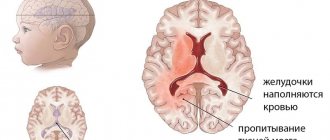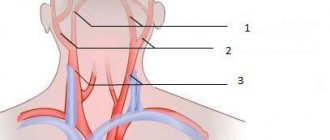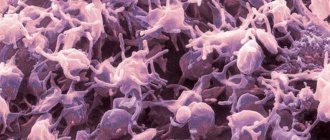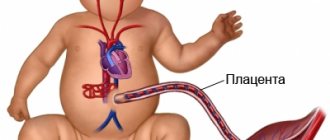What is low platelet count
Platelets are colorless spherical blood cells that are synthesized in the bone marrow. These elements live for 12 days, are responsible for the process of regeneration and coagulation, the elasticity of blood vessels, and carry nutrients.
A decrease or increase in quantity negatively affects the course of pregnancy and fetal development.
Acceptable standards:
- I trimester – 170-340 thousand/µl;
- II – 160-330 thousand/µl;
- III – 140-320 thousand/µl.
The number of platelet components shows the CBC. If the values are below the acceptable limit, thrombocytopenia is diagnosed.
Platelets and their role during pregnancy
Human blood consists of plasma and formed elements. The latter include platelets. Colorless blood cells are produced in the bone marrow and are spherical in shape. Their “life” is short - no more than 12 days, but during this time they have a huge responsibility - the process of blood clotting. If a capillary or vessel ruptures, a large number of platelets accumulate at the site of damage and blood loss stops. In addition, colorless bodies carry nutrients to all cells of the body.
The level of platelets in the blood of the expectant mother is determined during a general blood test. The lower and upper limits of the norm for women are 150 - 300 * 109 / l, respectively. Acceptable norms for pregnant women have been expanded, so if the studied indicator decreases slightly, it is too early to talk about the presence of pathology. During the period of bearing a baby, the normal range of platelet levels will be between 115 and 310 thousand units/µl. The physiological decrease in this indicator is caused by an increase in the volume of circulating blood (nutrition of the placenta and baby). Strictly speaking, the same number of platelets is distributed, but over a larger volume of blood, so the content of colorless cells per liter of blood decreases.
Why does it occur
A physiological decrease in the number of platelet elements is caused by an increase in the volume of circulating blood - the previous number of blood cells is distributed in a larger volume of fluid, which leads to the development of a pathological condition.
Thrombocytopenia during pregnancy - causes:
- aplastic anemia - a disorder in the formation of new blood cells;
- viral or bacterial infections, neuropathic conditions;
- vitamin deficiency – deficiency of folic acid and vitamin B12;
- allergy;
- severe intoxication due to antibacterial therapy, poisoning with alcohol, salts of heavy metals, and other toxic substances;
- HIV infection;
- placental abruption;
- intrauterine fetal death, gene mutations;
- severe form of gestosis;
- eclampsia - an increase in blood pressure to alarming levels;
- kidney disease, enlarged spleen, leukemia.
A reduction in the lifespan of blood cells occurs against the background of active hormonal changes in the body, or is hereditary.
What is thrombocytopenia
Thrombocytopenia is a persistent decrease in platelet count. The normal level of this blood element ranges from 150,000 to 400,000 platelets per microliter.
When platelet levels are low during pregnancy, below 150,000 per µl, thrombocytopenia is diagnosed. A slight decrease is not a cause for concern: no complications or deterioration in well-being will occur in the mother or child.
But an extreme decrease in platelets leads to serious complications. A pregnant woman needs medical attention.
Thrombocytopenia is the second most common blood disease during pregnancy after anemia, a lack of iron in the body. This occurs in 8-10% of all pregnancies.
Types of pathology
There are several types of the disease in pregnant women, but any form is characterized by a decrease in the level of colorless cells and bleeding.
| View | Description |
| Gestational | The level of platelet elements is 90 * 10 to the 9th power of units, the indicators decrease in the third trimester. If there are no other negative symptoms, the general condition is normal, then treatment is not carried out. |
| Autoimmune | The immune system fights against its own cells. In addition to a decrease in platelets, there is a high level of antiplatelet immunoglobulin type G. |
| Secondary | It develops against the background of radiation sickness, toxic brain damage, with some viral diseases - measles, chickenpox, scarlet fever, and when taking certain medications. |
| Idiopathic | The exact etiology of the pathology has not been identified. A small number of platelet cells are observed, but the process of their formation in the bone marrow is not impaired. |
How does childbirth go?
If the disease is not accompanied by additional complications, there is no prohibition on natural delivery.
If all medical recommendations are fully followed, the level of platelets in the blood may increase on its own before the onset of labor.
If the platelet concentration is below 40 thousand/mC, drug treatment is required.
Before giving birth, the expectant mother is prescribed hormonal medications. If treatment is ineffective, an injection of immunoglobulin may be administered.
It is prohibited to perform a cesarean section with thrombocytopenia. The entire birth process must take place under continuous medical supervision to avoid unnecessary trauma and bleeding.
Possible complications
If thrombocytopenia is not treated before delivery, complications may occur.
A low concentration of blood platelets provokes the following pathologies:
- severe internal bleeding;
- premature onset of labor;
- damage to cerebral vessels and hemorrhage in a newborn baby;
- inheritance of thrombocytopenia by a child.
Pathology requires treatment and medical supervision.
To reduce the risk of complications during childbirth, a woman should regularly visit a doctor who monitors her pregnancy and undergo all routine examinations.
Why is it dangerous?
If symptoms of thrombocytopenia appear in pregnant women, consultation with a therapist, hematologist, infectious disease specialist, or endocrinologist is required, since the disease is accompanied by risks for the mother and child.
Consequences:
- Severe uterine bleeding. In such cases, it is necessary to carry out premature delivery, depending on the gestational age, the outcome can be sad.
- Thrombocytopenia during childbirth is always accompanied by severe bleeding, which leads to the development of additional complications.
- With an autoimmune type of pathology, antibodies destroy blood elements in the child’s body. As a result, a congenital form of the disease develops, bleeding in the newborn.
It is not difficult to avoid dangerous consequences - just take regular tests and follow all the doctor’s recommendations.
Extreme treatment: how to increase platelets in the blood quickly?
When the level of blood cells in a pregnant woman decreases, the fastest way to get the desired effect is to correctly combine medication, folk treatment and diet. But the forum dedicated to the pathology of thrombocytopathy contains many stories about how in a short time you can actually increase the levels of this element in the blood.
This can only be done by transfusing platelet mass into the body. Before increasing the indicator and carrying out extreme treatment, the doctor must thoroughly examine the patient.
Often this method, which allows you to quickly normalize the platelet count, is necessary for people after chemotherapy. In this case, a number of additional drugs are also prescribed, since patients have elevated monocytes.
Signs
The clinical picture of pathology in pregnant women has a wider range of manifestations than in non-pregnant women. The longer the gestation period, the more intense and more often the unpleasant symptoms appear.
Signs:
- bruises, hemorrhages - often appear even at the slightest touch;
- small red rash on various parts of the body;
- nosebleeds, ear bleeding;
- bleeding gums, ulcers on the oral mucosa - sometimes such symptoms signal gingivitis in pregnant women, the level of colorless cells is normal;
- vascular network on the eyeballs, conjunctivitis.
The most dangerous manifestations are uterine and internal bleeding.
Diagnostics
Diagnosis of pathology is carried out on the basis of clinical studies of urine, plasma, and cerebrospinal fluid.
What tests are prescribed:
- blood test to determine the level of coagulation, detection of antibodies to platelet elements;
- general and biochemical blood test to assess the number of leukocytes, erythrocytes, platelets;
- urine test for hemosiderin - an iron-containing pigment formed during the breakdown of blood;
- aspiration puncture.
Additionally, an ultrasound is prescribed to study the condition of the spleen and kidneys.
Causes
Among the causes of thrombocytopenia, there are many factors that have not been fully studied in modern medicine.
Among the most common causes is excessive use of antibiotics, which causes subsequent intoxication. A small amount of vitamins is also a factor causing thrombocytopenia. Viral infections and eating foods with lots of preservatives also increase the risk of a dangerous drop in platelet levels. Diagnosis of the disease is complicated by the possibility of making a diagnosis only based on the results of a blood test. In this case, the patient may feel completely healthy and have no complaints of malaise and dizziness, which often occur when the composition of the blood changes.
Commonly occurring characteristic signs of the disease include frequent bleeding from the nose, gums, and bruising.
Treatment methods
A threatening decrease in platelet counts is rarely observed, mainly in women with serious chronic diseases.
Treatment methods for thrombocytopenia during pregnancy:
- corticosteroids - the drugs Prednisolone and Dexamethasone are considered the most effective; therapy is carried out in courses, the dosage is gradually reduced;
- immunosuppressive drugs – prescribed for the autoimmune form of the disease;
- plasma exchange;
- platelet transfusion - carried out if a cesarean section is necessary, if the number of cells is below 50 * 10 to 9 degrees / l;
- in rare cases, with an autoimmune type of pathology, the spleen is removed laparoscopically in the second trimester.
If the chronic form of the disease is observed before pregnancy, immunoglobulin injections must be given before conception.
Control during the postpartum period
If after the birth of the child the concentration of platelets in the blood has not returned to normal levels, additional treatment is prescribed.
As a rule, to normalize the condition, it is necessary to remove the spleen and take a course of hormonal medications.
In combination with medication and surgical treatment, the young mother must adhere to a special diet. It is based on products that help increase the concentration of blood platelets.
These include:
- cereals;
- whole wheat bread;
- beef;
- liver.
It is necessary to replenish the supply of vitamin B12 and folic acid. Therefore, additional intake of these substances in the form of vitamin complexes.
In addition, a young mother needs to regularly undergo a general blood test to determine platelet concentration. It is recommended to do this approximately once a month.
Thrombocytopenia during pregnancy is very dangerous not only for the woman, but also for the child.
A low concentration of blood platelets can cause excessive internal bleeding.
If left untreated and controlled, thrombocytopenia can cause miscarriage, early labor, and even intrauterine death of the child.
When diagnosing a deviation of this indicator from the norm, it is necessary to identify the cause that provoked the pathology.
It is advisable to normalize the woman’s condition before the onset of childbirth.











